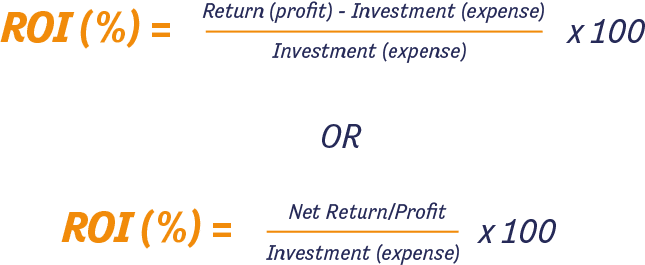intermediate
No one likes math until math is about money.
It’s a familiar scene: you’ve been saving for quite some time, maybe quit smoking or cut down on fast food, or went even as far as not throwing all your payroll into the Steam Summer Sale. One way or another, you find yourself now with some spare cash and a burning desire to invest.
Let’s say, you buy Bitcoin for $10,000. Then what? You have two options. The first one is to sit and do nothing. Maybe pray that Elon Musk won’t tweet anything edgy (again) that will cause Bitcoin to drop. Or, following the second option, you can calculate the return on investment property like a pro. As scary as it may sound, it’s not beyond the capabilities of a person who knows how to push buttons on a calculator and reads this neat little guide.
What Is the Return on Investment (ROI)?
Investments in cryptocurrencies can bring high returns: according to coinmarketcap, Bitcoin brought its investors more than 29,000% ROI, and Ethereum — more than 107,000%. Why does this — a whatchamacallit — ROI exist, and how does it work?
Return on investment, or ROI, is popular in different spheres, not only DeFi. Business sharks and business dolphins, marketers, startup entrepreneurs, real estate investors, and HR managers — all of them need a tool to predict profits. And the return on investment formula provides it.
ROI metric is sometimes called a “quick-and-dirty method” because it’s an easy formula that can be calculated on a napkin. Nonetheless, it’s a widely known financial metric that is usually used before any serious investments.
ROI is a formula that measures an investment’s performance, defining whether it’s efficient and profitable. It can be used to evaluate one or several different assets and compare them.
Don’t confuse ROI with ROR, which stands for rate of return. Know the main difference: ROR can denote a period of time, but ROI does not do it. Abbreviations like ROMI and ROAS also stand for different calculations. A subtle but important thing to remember.
How to Calculate Return on Investment (ROI)
Unlike the last season of Game of Thrones, ROI calculations won’t shatter your expectations. They’re always the same and quite simple. This investment property is calculated to avoid mistakes that would lead to a waste of money. The calculation gives a clear idea of the efficiency level of your assets, providing an opportunity to estimate the percentage of profit that you get after investing your hard-earned funds.

ROI is a percentage that’s calculated by dividing an investment’s profit (or loss) by its initial cost or outlay. To put it simply, you take a number that you gained from an investment and subtract the investment cost from it. This is your net income. Hang in there — we’re almost done. So, the number you get from subtraction is to be divided by the cost of investment. Not subtracted, divided. The number you get is the ROI. The higher it is, the more profitable the investment.
OK, OK, keep breathing, stay with us.
Why is the ROI metric represented by percentage if I get a number like 0.4 or 0.2? Well, you can’t just keep calculating ROI with regular numbers and get %. So, to get a percentage, multiply the number by 100: 0.4 × 100 = 40%.
Here Is a Video on How to Calculate ROI
For those of you precious visual learners we hitchhiked calculating ROI video from the internet:
ROI Formula
Visually, the ROI formula is quite simple and looks like this:
ROI = (Gain of Investment – Cost of Investment) / Cost of Investment
The first action is calculating your net income (investment property gain after costs). If you already know your net income, just divide it by investment cost. Mind that in some formulas you will find on the internet, investment costs are sometimes called investment base, but it means the same stuff. To get a percentage out of a number, multiply it by 100.

Via magora-systems.com because we were too lazy to open Microsoft Paint
ROI Example
ROI is the best way to learn the potential property value of cryptocurrencies you own. For example, if Elon Musk buys Solana at $120 USD/SOL, and the price spirals up to $400 USD/SOL, which is entirely possible given that Solana is now one of the primary currencies on OpenSea, then what’s the ROI going to be?
400 / 120 = 3.3 × 100 = 333.3% return on investment
Just looking at the percentage of profits makes us want to buy SOL right away.
An Alternative ROI Calculation
There are different formulas to calculate ROI for a business venture, but they are the same in essence. It’s either:
ROI = Money I Gained – Money I Spent / Total Cost of Investment
or
ROI = Investment Net Income (which is basically the same Money I Gained – Money I Spent) / Total Cost of Investment
or
ROI = Investment Gain / Investment Base (spoiler: it’s the same thing as above)
As you can see, an alternative way to calculate projected ROI is an illusion.
How to Calculate ROI for Startup
You invent the unmelting ice cream machine, which costs incurred $10,000,000. After selling ice cream for some time, you begin to hate it: the taste, the texture, everything.
You wish you were selling pooping flamingos instead.
You give up the machine for $30,000,000. In this case, your net profit is +$20,000,000. 20M/10M = 2. It means that your ROI is 200%. A good investment and a good ROI.
How to Calculate ROI for a Marketing Campaign
You are the head of ClearlyNotYouTube. Someone posted a meme about you on Reddit, resulting in 69,000 conversions and a profit of $1,000. That’s good because you only spent $2 on ads. Unfortunately, you will have $69,001,000 maintenance costs on lawyers because the real YouTube sued you.
ROI = $998 – $69 001 000 = –$69M. Divide –$69M by $2 to get the basic ROI calculation. Your ROI is not looking good. You will end up with what’s called negative ROI.
What Is Annualized ROI?
In shorthand, it’s the ROI you need if your investment opportunity is measured in years. An annualized ROI is an annual rate of return on investment, which takes into account how long the investment is held. It shows how your investment performs during a certain time period. The formula for yearly ROI is more complicated:
Annualized ROI = ((1 + ROI) 1/n – 1) × 100%
N in the formula stands for the number of years for investment.
Comparing Investments and Annualized ROI
The yearly ROI is a neat way to compare returns between various investments. For that, you will need the following formula:
AROIₓ = Annualized ROI for crypto X
AROIₙ = Annualized ROI for crypto N
Then, subtract the higher number from the lower to see how profitable is one crypto initial investment in comparison with the other.
How to Calculate ROI in Excel

As “not cool” as it sounds, making ROI calculations in Microsoft Excel is quicker than doing it on a calculator and much faster than doing it on a napkin. It also provides financial security.
Step 1. Open Excel.
Step 2. Wait till it loads.
Step 3. Wait some more till it loads, maybe make some tea, read a couple of Shakespeare’s sonnets — they’re good for the soul.
Step 4. Excel finally loads, hurray.
Step 5. With a blank workbook, create the following cells for ROI calculations:
- Transaction date
- The price at the time of purchase
- The amount you paid for crypto USD, EUR, CAS, etc.
- The number of coins you bought
The template will look like this (examples by Steven Cheong on Medium):

Enter the current price of crypto, as shown in the example. For Google Sheets, you can type “=GOOGLEFINANCE(Your crypto name)” in the current price cell. To get a ROI, use the following formula: return = (current price – average price) / total costs.

Voilà, that’s how you calculate the ROI in Excel without a third party ROI calculator.
Disclaimer: Please note that the contents of this article are not financial or investing advice. The information provided in this article is the author’s opinion only and should not be considered as offering trading or investing recommendations. We do not make any warranties about the completeness, reliability and accuracy of this information. The cryptocurrency market suffers from high volatility and occasional arbitrary movements. Any investor, trader, or regular crypto users should research multiple viewpoints and be familiar with all local regulations before committing to an investment.

